A properly composed diet will allow you to forget the excruciating pain in the joints and live a full life. We are talking about the diet for arthritis: what is useful and what is not.

Arthritis is a systemic chronic metabolic disease that causes inflammation, swelling and pain in the joints. The disease is associated with the accumulation and retention in the body of uric acid salts - urates. Arthritis has been known since ancient times, its main symptoms were described by ancient physicians. Many famous people suffered from arthritis, for example Alexander the Great, emperors and empresses, the English King Henry VIII, the German scientist Gottfried Leibniz, the philosophers Voltaire Kant and Schopenhauer.
Gout is still a very common disease. Most often, this disease affects men. In terms of the age at which the first seizure usually occurs, it is in men 35-45 years, and in women it is 45-50 years.
arthritis symptoms
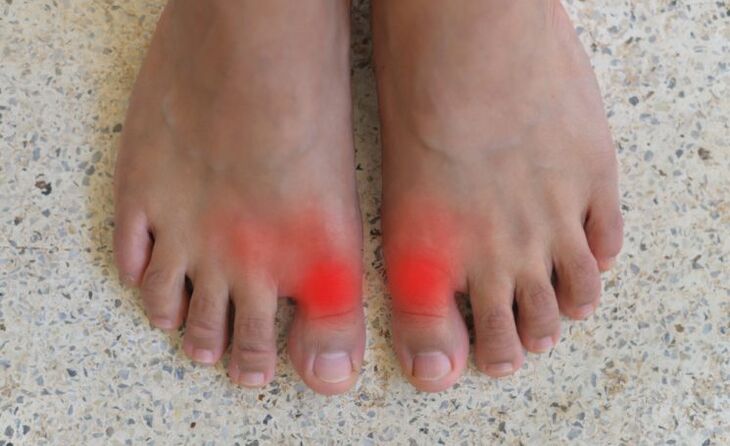
A characteristic sign of arthritis is the formation of so-called tophi (deposition of uric acid salts in the form of nodules and bumps in the connective tissue). Arthritis sufferers complain of acute pain in the joints - most often the big toe is affected. From the ancient Greek language, the name of the disease is translated as "leg in a trap", as patients are most often concerned about acute pain in the joints of the feet. The intensity of pain increases rapidly and reaches a peak after approx. 24-48 hours. The joint area is red and swollen. Body temperature may rise, chills appear. Gout attacks are also unpleasant because they restrict the patient's movement. If you do not resort to appropriate treatment, the acute period lasts about a week, then the symptoms gradually subside. Arthritis can develop: pain attacks become more frequent, new joints, such as elbows, hands, are involved in the pathological process. Due to the growth and expansion of the nodules, the joints are deformed, their mobility and functionality are impaired. And that leads to movement problems: the patient becomes less mobile. In the later stages, arthritis can lead to the development of urolithiasis.
Depending on the nature of the course, the disease can be acute (acute arthritis) or chronic (recurrent arthritis). There are also atypical forms of arthritis, for example pseudophlegmonous, asthenic, rheumatoid-like, etc. They are much less common.
Causes of the development of the disease
As we have already said, arthritis develops when a lot of uric acid is formed in the body, which is not promptly excreted from the body. A wide range of factors can contribute to this. Here are the main causes of high uric acid levels and the development of arthritis.
- hereditary disposition. Most often it manifests itself in the form of various genetic disorders in which the amount of some enzyme is reduced in the body.
- Increased intake of purine bases in the body. These substances are contained in the DNA and RNA of living organisms and are involved in the transmission of hereditary information. Purine bases enter the body with food, beverages and also during the breakdown of the body's own cells. In the Middle Ages, arthritis was called "king's disease". This is explained by the love of the nobility for plentiful meals. The body of those who abused meat and alcohol (and there are most of all purines) could not cope with the enormous concentration of uric acid. Ordinary people ate poorly, mostly plant foods, and therefore rarely suffered from arthritis.
- Problems with urinary excretion in the urine. Usually seen in chronic kidney disease. It is generally accepted that arthritis in such cases is secondary, that is, it is a consequence of another disease. If it is eliminated, the arthritis will also disappear.
Treatment and prevention of arthritis
The success of the treatment of arthritis is an integrated approach. If possible, specialists try to determine the cause of the disease and eliminate it. However, this is not always possible, so one has to limit oneself to symptomatic treatment aimed at eliminating the manifestations of the disease and improving the quality of life for an arthritic sufferer.
The main directions in the treatment of arthritis
- Medical carewith anti-inflammatory and anti-inflammatory drugs. Anti-inflammatory drugs are mainly taken during an exacerbation to relieve pain and swelling. Antigigt - for a long time, sometimes for life. This is a group of drugs that directly affect the metabolism of purine bases and uric acid in the body.
- local treatment.It is prescribed both during the period of remission and during exacerbation. It consists in the use of compresses with painkillers and anti-inflammatory drugs as well as physiotherapy procedures. During the remission period, applications with paraffin, therapeutic mud are useful - this helps eliminate urates and improves joint mobility.
- Surgery.Assign with a strong growth of nodes and cones. They are removed to avoid severe deformation of the joints and limit their mobility.
- Dieting.Diet plays an important role in the prevention and treatment of arthritis. The main goal of such a diet is to reduce the content of uric acid compounds in the body. If the therapeutic and prophylactic diet is followed, purine bases practically do not enter the body from the outside and the level of uric acid decreases. By limiting consumption or completely removing certain foods from the diet, we prevent the development of the disease and delay the next attack. It is recommended to follow a therapeutic and prophylactic diet for rheumatic patients throughout life, and not only during periods of exacerbations.
How to make a diet
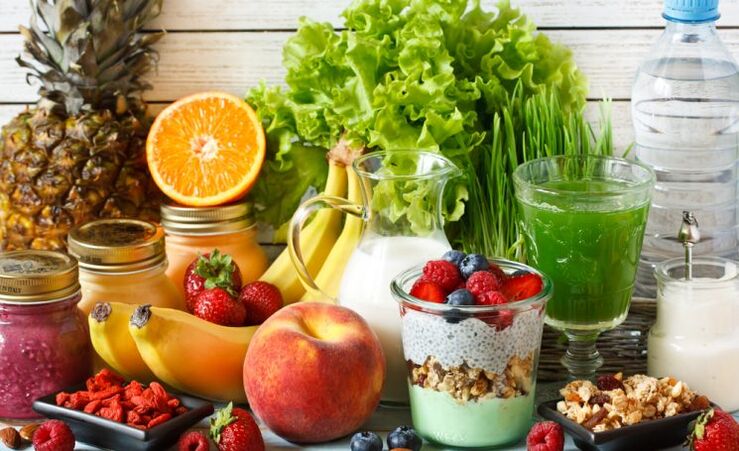
Experts recommend taking diet table # 6 as a basis for arthritis. This therapeutic and preventive diet was developed by a well-known nutritionist for patients with diseases that are accompanied by accumulation of uric acid in the body: arthritis, urolithiasis and uric acid. on diathesis. All of these disorders are metabolic pathologies and cause serious complications. A special diet helps to reduce the concentration of uric acid in the bloodstream and normalize the metabolism in the body. Thanks to a special diet it is possible to reduce the formation of uric acid and the accumulation of urate in the kidneys and joint spaces. The diet also prevents the accumulation of purine bases, leading to arthritis. If you stick to it, you can quickly improve your general condition, reduce pain and discomfort in the joints.
Features in diet table number 6
The therapeutic diet is balanced in terms of chemical composition and caloric content of products, adequate in terms of the content of minerals, vitamins, proteins, fats and carbohydrates. The energy intensity is 2700-3000 kcal. If you are overweight, it is recommended to reduce the total calories by reducing carbohydrates.
- The amount of fat is 80-90 g per day. Preference should be given to fats of vegetable origin, the source of which is vegetable oils.
- The daily amount of protein is 70-80 g, while at least half of the stated amount should come from vegetable protein foods.
- The amount of carbohydrates is 380-400 g per day with normal body weight. With overweight and obesity, the amount of carbohydrates is reduced to 250-300 g per.
- The amount of salt should not exceed 10 g perday.
- The daily amount of liquid consumed should not exceed 1, 5-2 liters (excluding the first dishes).
The diet for arthritis does not impose strict restrictions, therefore it is usually well tolerated. Food must be cooked, baked, steamed. Try to avoid frying. It causes the formation of a large number of extractives and carcinogens, which affect digestive, urinary and cardiovascular systems. You should eat fractionally, every 2-3 hours, in moderate portions without overeating.
Allowed foods for arthritis
The basis of the therapeutic diet for arthritis is alkaline foods: they normalize the metabolism of purine bases and also reduce the amount of uric acid.
What can you eat with arthritis?
- Any kind of vegetable - both fresh and thermally processed.
- Bakery products made from rye and wheat flour, as well as with the addition of wheat bran.
- First dishes prepared in a weak vegetable and fish broth, vegetarian okroshka, beets, lean pickle and cabbage soup without meat.
- Milk and sour milk products: low-fat kefir, coagulated milk, whole milk, low-fat sour cream, natural yoghurt, fermented baked milk and low-fat cottage cheese.
- Fruits and berries fresh and thermally processed.
- Green and black tea with lemon, honey and milk. Homemade fruit and berry kisses, vegetable and fruit juices, berry fruit drinks. Herbal infusions (from chamomile flowers, rose hips), fruit compotes, chicory.
- Desserts and sweets: natural honey, marshmallows, natural jams, berry jams, marmalades, homemade marshmallows.
- Fats: refined sunflower, corn, olives, linseed oil. Butter is also allowed.
The listed foods and foods are considered safe against arthritis. There are also a number of products that you can not exclude from the menu, but limit their use.
- Quail and chicken eggs, cooked in the form of steamed omelettes, hard-boiled or soft-boiled (not more than 1 egg a day).
- From meat products it is allowed to eat veal, lean beef, rabbit, turkey and chicken. From fish - fish of diet variants. Meat and fish dishes should not be consumed more than three times a week, preferably cooked. Thanks to this heat treatment method, meat and fish are purified of purine bases, extracts and uric acid fragments.
- Pasta is recommended to be kept to a minimum.
What not to eat with arthritis
Your diet should not include foods that contain large amounts of purine bases and uric acid. Here are foods not recommended for arthritis.
- Alcoholic and carbonated beverages.
- Chocolate, cocoa.
- Starters cooked in meat and strong fish broth.
- All kinds of nuts and legumes, grape juice.
- Hard and pickled cheeses.
- Sausage products, smoked products, sausages, canned fish and meat, offal, as well as meat and fish ingredients with a high fat content.
- All kinds of appetizers, pates, sauces, condiments, spices, ketchups, mayonnaise, mustard, grated horseradish.
- Products from butter and pastry, cakes, chocolate and caramel candies.
Sample menu for the week
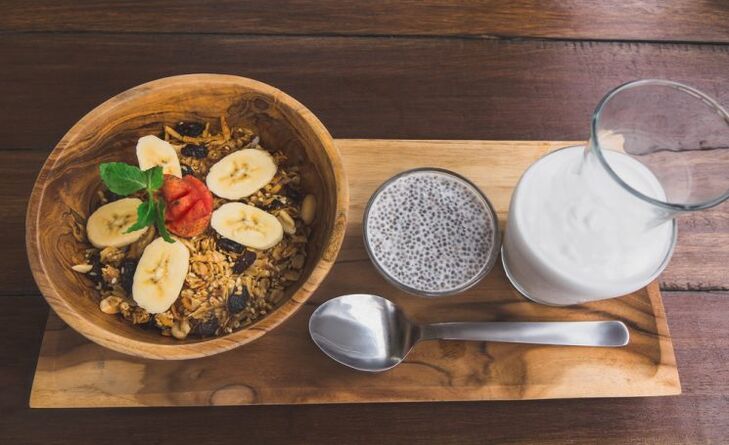
Here is a sample menu for seven days for those with arthritis. It can be adjusted according to your preferences.
Monday
Breakfast:vegetable salad dressed with vegetable oil (sunflower, corn or olives); 1 soft-boiled chicken egg; pumpkin or carrot juice.
Lunch:pumpkin baked with honey; a glass of whole milk or natural yogurt.
Dinner:boiled chicken breast with vegetable stew; a glass of orange or apple juice.
Afternoon snack:vegetarian borscht with potatoes; boiled fish fillets; weak green tea or rosehip drink.
Dinner:vegetarian cabbage rolls; fruit and berry jellies; low-fat cottage cheese with the addition of dried fruits.
Before going to bed, drink a glass of low-fat milk or kefir.
Tuesday
Breakfast:scrambled eggs with vegetable salad seasoned with vegetable oil (corn, olives or sunflower), a glass of fruit or vegetable juice.
Lunch:puree from any fruit or vegetable; cottage cheese mass with the addition of dried fruits; a glass of herbal tea.
Dinner:stewed zucchini with fresh herbs; mashed potatoes; vegetable salad, black or green tea.
Afternoon snack:a portion of fresh berries or fruits; milkshake or a glass of whole milk.
Dinner:cottage cheese with the addition of berry jam or dried fruit; compote of berries and fruits.
Wednesday
Breakfast:boiled rice porridge with the addition of grated apple; faint black or green tea.
Lunch:a serving of fruit salad seasoned with natural yogurt.
Dinner:vegetarian cabbage soup; squash chops; a glass of whole milk
Afternoon snack:a glass of fermented baked milk or kefir; portion of berries.
Dinner:pancakes with fruit filling; fruit and berry compote.
Thursday
Breakfast:cottage cheese and carrot stew; oatmeal; fruit compote.
Lunch:homemade noodles cooked in milk.
Dinner:steam beef chops with stewed white cabbage; boiled buckwheat porridge, pumpkin juice.
Afternoon snack:carrot juice.
Dinner:salad of boiled beets and carrots, seasoned with olive oil; fruit jelly.
Friday
Breakfast:soufflé ostemasse; fruit or vegetable juice.
Lunch:natural yogurt with the addition of wheat bran.
Dinner:white cabbage and grated carrot salad; vegetarian soup; tomato juice.
Afternoon snack:fruit jelly or a serving of fruit.
Dinner:baked vegetables; oatmeal, faint green or black tea.
Saturday
Breakfast:steam cheesecakes; natural yogurt; fruit jelly.
Lunch:corn or oatmeal with milk.
Dinner: steamed diet fish with mashed potatoes; vegetarian soup with zucchini; faint black tea with lemon.
Afternoon snack:berries or milkshake.
Dinner:vegetable salad; porridge from cornmeal; pumpkin, apple or carrot juice.
Sunday
Breakfast:vegetable salad; a slice of bread with bran; hyben drik.
Lunch:carrot-pumpkin salad, 1 soft-boiled chicken egg.
Dinner:potato chops with the addition of grated zucchini; homemade noodles cooked in milk; fruit jelly.
Afternoon snack:cottage cheese casserole with fruit.
Dinner:vegetable bowl rolls; a glass of whole milk or low-fat kefir.
Recipes
Vegetarian vegetable borscht
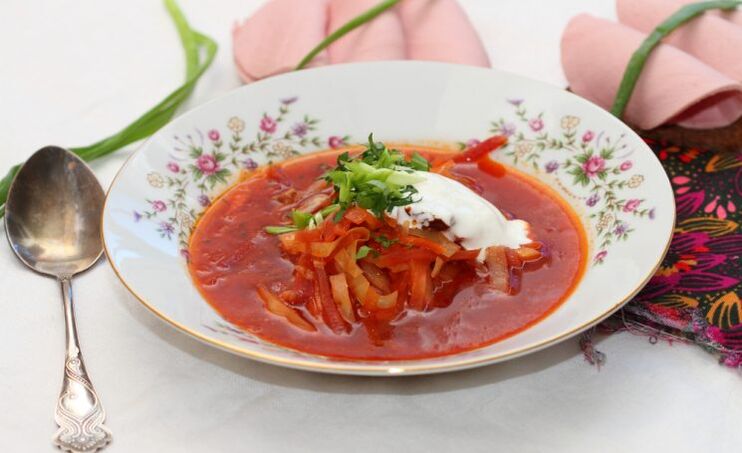
Ingredients:2, 5 liters of water, 1 onion, 2 carrots, 1 beetroot, 1 tomato, 1 celery root or stem, 2 potatoes, 200 g white cabbage, salt, pepper - to taste, herbs (dill, parsley), low-fat sour cream or natural yogurt -for serving.
Instruction.Put vegetables cut into small cubes or grated on a coarse grater in boiling water: onions, carrots, celery, beets, potatoes, cabbage, tomatoes (without peel). Cook until the vegetables are ready. Salt, taste. Then add finely chopped greens. Remove the pan from the heat and let the borscht simmer. Serve with sour cream or yoghurt (optional). In the finished borscht you can put a piece of lean boiled beef.
Omelette with poultry or meat

Ingredients:turkey breast fillet (chicken, guinea fowl) without skin or lean cooked meat (beef, veal), 2 eggs, 2 tbsp. l. low-fat milk, salt to taste.
Instruction.Beat eggs with milk. Salt. Pieces of boiled or baked poultry (meat), pour over the stirred mass. Bake on both sides in the microwave, slow cooker or in a deep frying pan.
Boiled cod
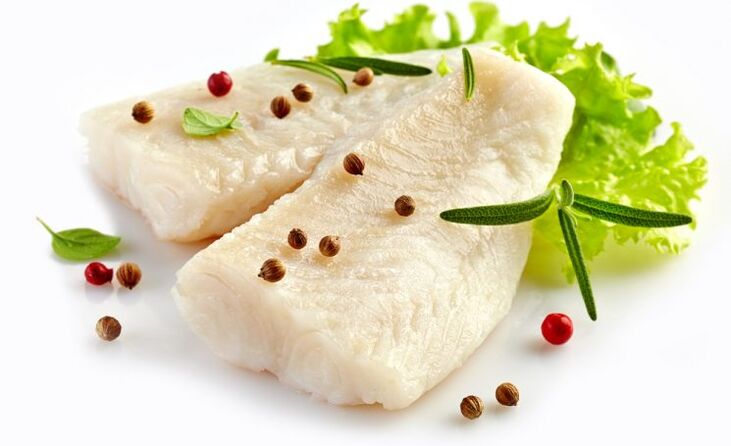
Ingredients:500 g cod fillet, 1 tsp. lemon juice, 1 onion, 1 bay leaf, 1 tbsp. l. olive oil, parsley root (to taste), peppercorns (4-5 peas), herbs (dill, parsley) - 1 tbsp. l. , salt to taste.
Instruction.Rinse the fillet in cold water with the addition of lemon, cut into portions. Put the pieces in the broth boiling with the roots and spices so that the water covers the fish. Saute the cod under a lid for 12 minutes. Serve with the vegetable stew.
Carrot, apple and pumpkin salad
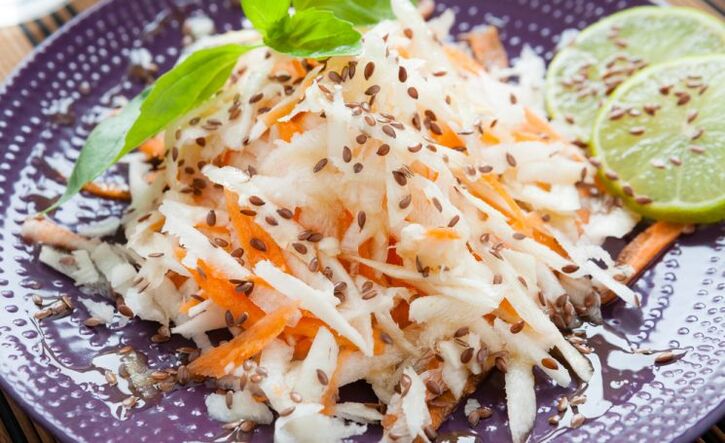
Ingredients:100 g fresh pumpkin, 1 medium carrot, 1 green apple, 1 tsp. lemon juice, 2-3 slices of orange or mandarin.
Instruction.Rub the vegetables on a coarse grater, mix. Add lemon juice and garnish the salad with orange (mandarin) slices.
Pike rolls with Chinese cabbage
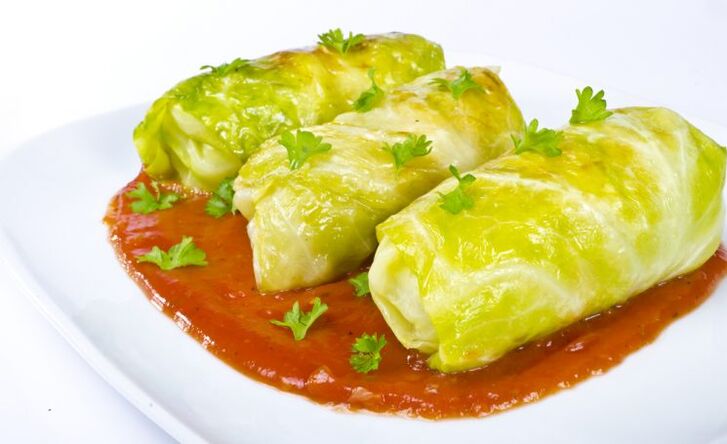
Ingredients:500 g pikeperch, 200 g cottage cheese (5%), 4 egg whites, 1 green Chinese cabbage, salt and pepper to taste.
Instruction.Grind with a mixer or before the pikeperch twice through a meat mincer. Then mix with the curd. Whisk the whites and add to the mass, mix, salt, pepper. Divide minced meat into 4 parts and place each on a separate piece of foil, greased with olive oil. Roll up into a roll, attaching the edges. Cook in a double boiler for 10-14 minutes. Wash the cabbage, separate it into leaves, salt, pepper and cook in a double boiler for 10 minutes. Place cabbage leaves on a plate, sandar rolls taken out of foil on them.
The vegetable stew
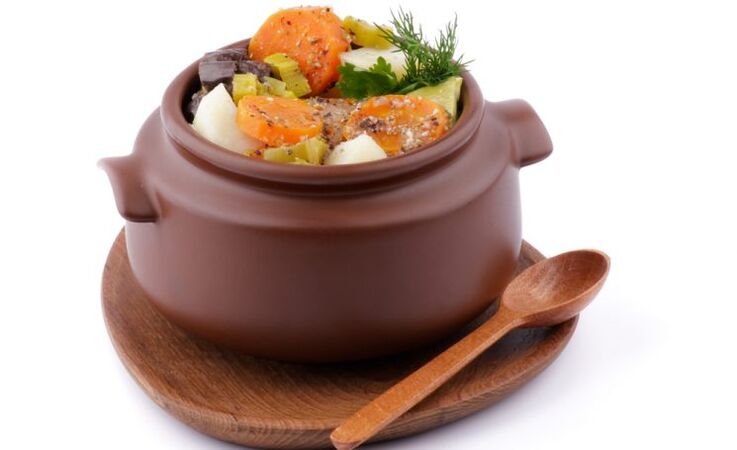
Ingredients:1 onion, 1 carrot, 1 tomato, 200 g white cabbage, 1 potato, 1 pepper, 100 g small corn, 1 tbsp. l. vegetable oil, herbs (dill, parsley, celery), salt, pepper to taste.
Instruction.Put finely chopped onion, grated carrots, peeled and chopped tomato in a pan heated with oil. Save easily. Then add cabbage and potatoes cut into squares, as well as corn. Stir, add a little water, put lid on and simmer until done. Five minutes before preparation, add pepper and finely chopped greens.
vegetable stew

Ingredients:1 onion, 1 carrot, 300 g cauliflower, 1 potato, 1-2 eggs, herbs (dill, parsley, celery), salt and pepper to taste.
Instruction.In a deep baking tray, greased with olive oil, place a mixture of vegetables: finely chopped onions and carrots, cabbage and potatoes cut into squares. Stir, add finely chopped greens, pepper, salt, beaten egg. Put in an oven preheated to 200 degrees. Bake for 20-25 minutes.
Zucchini rolls with cottage cheese
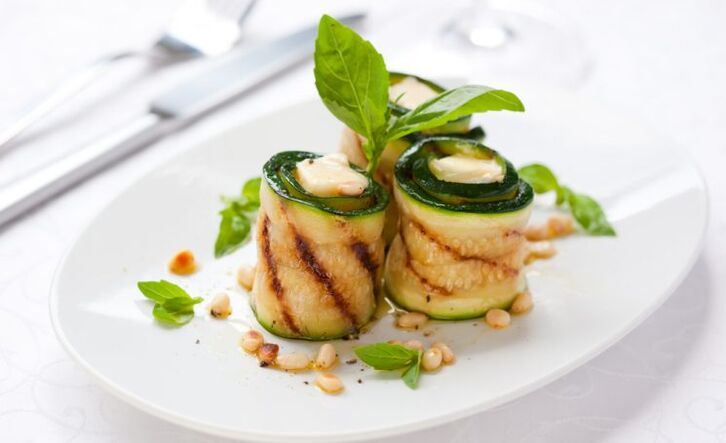
Ingredients:2 medium zucchini, 1/2 red pepper (without seeds), 1 cucumber, 100 g low-fat cottage cheese, 1 bunch of arugula, 1 tbsp. l. olive oil, 1 dl. finely chopped fresh herbs, salt to taste.
Instruction.Wash the zucchini, cut it into thin longitudinal strips, fry lightly on both sides with olive oil for 2 minutes on each side (can be baked in the oven). Mix cottage cheese with herbs, salt to taste. Pepper and cucumber cut into thin longitudinal strips. Put some cottage cheese on the end of the squash strip. Add a few strips of red pepper, cucumber, arugula leaves, roll up and place on a platter vertically.
Curd with apples

Ingredients:400 g fat-free cottage cheese, 2 eggs, 1 tsp. starch, 1/4 tsp. salt, 1 tbsp. l. sugar, 2 Antonovka apples.
Instruction.Beat eggs with salt and sugar, add cottage cheese and starch. Peel the apples, remove the core, cut them into small cubes and add the mass. Mix everything together. Microwave for 12 minutes or oven until cooked through. Serve with yogurt, honey or jam.
Curd of dessert berries

Ingredients:400 g low-fat cottage cheese, 100 g fresh berries, 2 egg whites, 1 tbsp. l. sugar, 12 g gelatin, 1/4 bag vanilla.
Instruction.Soak gelatin in 5-7 tablespoons cold water. Whisk the whites. Add vanillin, sugar to cottage cheese, add whipped proteins. Melt the gelatin over low heat until dissolved and add the curd, whisk. Refrigerate for 5 hours. Serve garnished with berries.

































